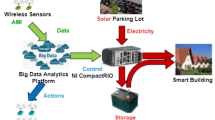Abstract
Accurate electricity forecasting has become a very important research field for high-efficiency electricity production. But the hybrid data-driven models for load forecasting are rarely studied. This paper presents a novel hybrid data-driven “PEK” model for predicting the daily total load. The proposed hybrid model is mainly constructed by various function approximators, which containing the partial mutual information (PMI)-based input variable selection (IVS), ensemble artificial neural network-based output estimation and K-nearest neighbor regression-based output error estimation. The PMI-based IVS algorithm is used to select the input variables, resulting in a good compromise between the parsimony and adequacy of the input information. After that, the topology and parameter calibration of the PEK model are implemented by the NSGA-II multi-objective optimization algorithm. The electricity load demands from years 2010 to 2012 of the Shuyang hydrothermal station are chosen as a case study to verify the performance of the PEK model. Simulation results show that this model obtains significantly better accuracy in the prediction of daily total load.





Similar content being viewed by others
References
Baek Y, Hong DH, Jang G (2005) Short-term load forecasting for the holidays using fuzzy linear regression method. IEEE Trans Power Syst 20(1):96–101
Zheng T, Girgis AA, Makram EB (2000) A hybrid wavelet-Kalman filter method for load forecasting. Elect Power Syst Res 54(1):11–17
Connor JT, Martin RD, Atlas LE (1994) Recurrent neural networks and robust time series prediction. IEEE Trans Neural Netw 5(2):240–254
Dordonnat V, Koopman SJ, Ooms M, Dessertaine A, Collet J (2008) An hourly periodic state space model for modelling French national electricity load. Int J Forecast 24(4):566–587
Taylor JW (2003) Short-term electricity demand forecasting using double seasonal exponential smoothing. J Oper Res Soc 54:799–805
Govindaraju RS (2000) Artificial neural networks in hydrology. II: hydrologic applications. J Hydrol Eng 5(2):124–137
Legates DR, McCabe GJ (1999) Evaluating the use of ‘goodness-of-fit’ measures in hydrologic and hydroclimatic model validation. Water Resour Res 35:233–241
Talei A, Chua LHC (2010) A novel application of a neuro-fuzzy computational technique in event-based rainfall-runoff modeling. Expert Syst Appl 37(12):7456–7468
Talei A, Chua LHC (2012) Influence of lag time on event-based rainfall-runoff modeling using the data driven approach. J Hydrol 438-439:223–233
Lin CT, Chou LD, Chen YM, Tseng LM (2014) A hybrid economic indices based short-term load forecasting system. Int J Electr Power Energy Syst 54:293–305
Szkuta BR, Sanabria LA, Dillon TS (1999) Electricity price short-term forecasting using artificial neural networks. IEEE Trans Power Syst 14(3):851–857
Beccali M, Cellura M, Brano VL, Marvuglia A (2004) Forecasting daily urban electric load profiles using artificial neural networks. Energy Conv Manag 45(18–19):2879–2900
Pai PF, Hong WC (2005) Support vector machines with simulated annealing algorithms in electricity load forecasting. Energy Conv Manag 46(17):2669–2688
Sharma A (2000) Seasonal to interannual rainfall probabilistic forecasts for improved water supply management: part 1-A strategy for system predictor identification. J Hydrol 239(1–4):232–239
Bowden GJ, Dandy GC, Maier HR (2005) Input determination for neural network models in water resources applications. Part 1-background and methodology. J Hydrol 301:75–92
May RJ, Dandy GC, Maier HR, Nixon JB (2008) Application of partial mutual information variable selection to ANN forecasting of water quality in water distribution systems. Environ Model Softw 23(10–11):1289–1299
Admuthe L, Apte S, Admuthe S (2009) Topology and parameter optimization of ANN using genetic algorithm for application of textiles. In: IEEE international workshop on intelligent data acquisition and advanced computing systems: technology and applications, 21–23 Sept, pp 278–282. doi:10.1109/IDAACS.2009.5342981
Yu J, Wang S, Xi L (2008) Evolving artificial neural networks using an improved PSO and DPSO. Neurocomputing 71:1054–1060
Deb K, Pratap A, Agarwal S, Meyarivan T (2002) A fast and elitist multiobjective genetic algorithm: NSGA-II. IEEE Trans Evolut Comput 6(2):182–197
Zhang D, Cai K (2003) A genetic-algorithm-based two-stage learning scheme for neural networks. J Syst Simul 15(8):1088–1090 (in Chinese)
Coulibaly P, Anctil F, Bobée B (2000) Daily reservoir inflow forecasting using artificial neural networks with stopped 1 training approach. J Hydrol 230(3–4):244–257
Zhao Z, Zhang Y, Liao H (2008) Design of ensemble neural network using the Akaike information criterion. Eng Appl Artif Intell 21(8):1182–1188
Sharma A, Luk KC, Cordery I, Lall U (2000) Seasonal to interannual rainfall probabilistic forecasts for improved water supply management: part 2-Predictor identification of quarterly rainfall using ocean–atmosphere information. J Hydrol 239(1–4):240–248
Abdeslam DO, Wira P, Merckle J, Flieller D (2007) A unified artificial neural network architecture for active power filters. IEEE Trans Ind Electron 54(1):61–76
Panchal G, Ganatra A, Kosta YP (2010) Searching most efficient neural network architecture using Akaike’s information criterion (AIC). Int J Comput Appl 1(5):975–8887
Kanal L (1974) Patterns in pattern recognition: 1968–1974. IEEE Trans Inform Theory 20(6):697–722
Author information
Authors and Affiliations
Corresponding author
Rights and permissions
About this article
Cite this article
Dong, Jr., Zheng, Cy., Kan, Gy. et al. Applying the ensemble artificial neural network-based hybrid data-driven model to daily total load forecasting. Neural Comput & Applic 26, 603–611 (2015). https://doi.org/10.1007/s00521-014-1727-5
Received:
Accepted:
Published:
Issue Date:
DOI: https://doi.org/10.1007/s00521-014-1727-5




